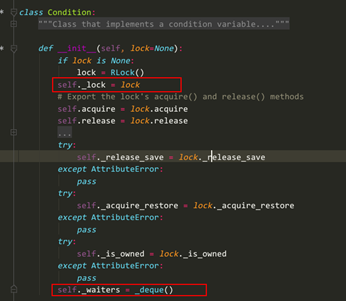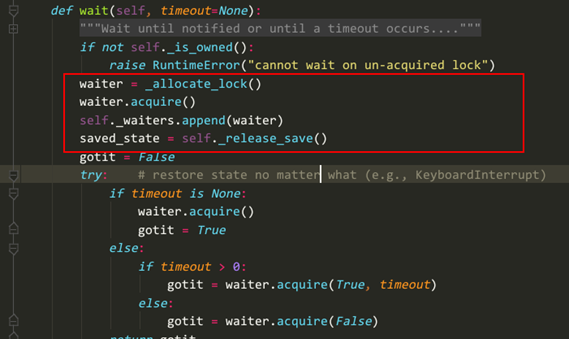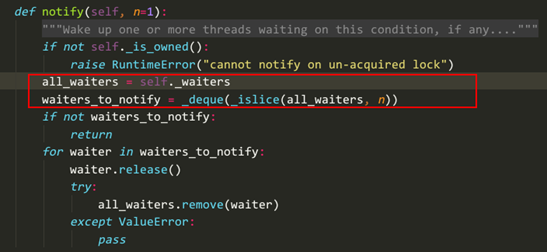11.1 python中的GIL
# coding=utf-8 # gil global interpreter lock (cpython) # python中一个线程对应于c语言中的一个线程 # gil使得同一个时刻只有一个线程在一个cpu上执行字节码, 无法将多个线程映射到多个cpu上执行 # gil会根据执行的字节码行数以及时间片释放gil, # gil在遇到io的操作时候主动释放 import dis
def add(a): a = a + 1 return a print(dis.dis(add)) total = 0 def add(): # 1. dosomething1 # 2. io操作 # 1. dosomething3 global total for i in range(1000000): total += 1 def desc(): global total for i in range(1000000): total -= 1 import threading thread1 = threading.Thread(target=add) thread2 = threading.Thread(target=desc) thread1.start() thread2.start() thread1.join() thread2.join() print(total) # 在IO频繁的时候是很适合的
执行多少行后字节码会释放
11.2 python多线程编程
操作系统最小的执行单元
# coding=utf-8 # __auther__ = 'lewen' import time import threading def get_detail_html(url): print("get detail html started") time.sleep(2) print("get detail html end") def get_detail_url(url): print("get detail url started") time.sleep(4) print("get detail url end") if __name__ == "__main__": # 在主线程起两个线程 thread1 = threading.Thread(target=get_detail_html, args=("",)) thread2 = threading.Thread(target=get_detail_url, args=("",)) # thread1.setDaemon(True) # thread2.setDaemon(True) # 守护线程,当主线程退出的时候, 子线程kill掉 start_time = time.time() thread1.start() thread2.start() thread1.join() # 等待线程的执行完成,才会执行下面 thread2.join() print("last time: {}".format(time.time() - start_time))
通过集成Thread来实现多线程
class GetDetailHtml(threading.Thread): def __init__(self, name): # py2 必须在括号写类名 # 继承父类的name super().__init__(name=name) def run(self): print("get detail html started") time.sleep(2) print("get detail html end") class GetDetailUrl(threading.Thread): def __init__(self, name): super().__init__(name=name) def run(self): print("get detail url started") time.sleep(4) print("get detail url end") if __name__ == "__main__": thread1 = GetDetailHtml("get_detail_html") thread2 = GetDetailUrl("get_detail_url") start_time = time.time() thread1.start() thread2.start() thread1.join() thread2.join() print("last time: {}".format(time.time() - start_time))
11.3 线程间通信-Queue
共用变量

# 线程间通信 import time import threading from chapter11 import variables from threading import Condition detail_url_list = [] # 1. 生产者当生产10个url以后就就等待,保证detail_url_list中最多只有十个url # 2. 当url_list为空的时候,消费者就暂停 def get_detail_html(lock): # 爬取文章详情页 detail_url_list = variables.detail_url_list # 将共享变量存放到文件中去 while True: if len(variables.detail_url_list): if len(detail_url_list): url = detail_url_list.pop() # for url in detail_url_list: print("get detail html started") time.sleep(2) print("get detail html end") else: time.sleep(1) def get_detail_url(lock): # 爬取文章列表页 detail_url_list = variables.detail_url_list while True: print("get detail url started") time.sleep(4) for i in range(20): if len(detail_url_list) >= 10: time.sleep(1) else: detail_url_list.append("http://projectsedu.com/{id}".format(id=i)) print("get detail url end") # 1. 线程通信方式- 共享变量 if __name__ == "__main__": thread_detail_url = threading.Thread(target=get_detail_url, args=(lock,)) for i in range(10): html_thread = threading.Thread(target=get_detail_html, args=(lock,)) html_thread.start() # # thread2 = GetDetailUrl("get_detail_url") start_time = time.time() # 当主线程退出的时候, 子线程kill掉 print("last time: {}".format(time.time() - start_time))

from queue import Queue import time import threading def get_detail_html(queue): # 爬取文章详情页 while True: url = queue.get() # 阻塞,没有会停在这 print(url) # 内部基于deque print("get detail html started") time.sleep(1) print("get detail html end") def get_detail_url(queue): # 爬取文章列表页 while True: print("get detail url started") time.sleep(2) for i in range(9): queue.put("http://www.baidu.com/s?wd=".format(id=i)) print(queue.qsize()) print("get detail url end") # 1. 线程通信方式- 共享变量 if __name__ == "__main__": detail_url_queue = Queue(maxsize=1000) thread_detail_url = threading.Thread(target=get_detail_url, args=(detail_url_queue,)) html_thread_list = [] for i in range(10): html_thread = threading.Thread(target=get_detail_html, args=(detail_url_queue,)) html_thread.start() html_thread_list.append(html_thread) start_time = time.time() for h in html_thread_list: h.join() # detail_url_queue.join() # 这里想退出,必须等到 detail_url_queue.task_done()调用,才会退出 print("last time: {}".format(time.time() - start_time))
11.4 线程同步(Lock、RLock、Semaphores、Condition)

from threading import Lock, RLock, Condition # 可重入的锁 # Lock 不能重复调用 total = 0 lock = RLock() # 在同一个线程里面,可以连续调用多次acquire, 一定要注意acquire的次数要和release的次数相等 # 多个线程之间仍会竞争 def add(): global lock global total for i in range(1000000): lock.acquire() lock.acquire() # 一个线程里面重入的锁 total += 1 lock.release() lock.release() def desc(): global total global lock for i in range(1000000): lock.acquire() total -= 1 lock.release() import threading thread1 = threading.Thread(target=add) thread2 = threading.Thread(target=desc) thread1.start() thread2.start() thread1.join() thread2.join() print(total) # 1. 用锁会影响性能 # 2. 锁会引起死锁 # 死锁的情况 A(a,b) """ A(a、b) acquire (a) acquire (b) # 阻塞住,死在这 B(b、a) acquire (b) # 交互死锁,资源竞争 acquire (a) """
condition 使用以及源码分析

import threading class XiaoAi(threading.Thread): def __init__(self, lock): super().__init__(name="小爱") self.lock = lock def run(self): self.lock.acquire() print("{} : 在 ".format(self.name)) self.lock.release() self.lock.acquire() print("{} : 好啊 ".format(self.name)) self.lock.release() class TianMao(threading.Thread): def __init__(self, lock): super().__init__(name="天猫精灵") self.lock = lock def run(self): self.lock.acquire() print("{} : 小爱同学 ".format(self.name)) self.lock.release() self.lock.acquire() print("{} : 我们来对古诗吧 ".format(self.name)) self.lock.release() if __name__ == "__main__": lock = threading.Lock() xiaoai = XiaoAi(lock) tianmao = TianMao(lock) tianmao.start() xiaoai.start() # --- 天猫精灵 : 小爱同学 天猫精灵 : 我们来对古诗吧 小爱 : 在 小爱 : 好啊
class XiaoAi(threading.Thread): def __init__(self, cond): super().__init__(name="小爱") self.cond = cond def run(self): with self.cond:#第一把锁 self.cond.wait() print("{} : 在 ".format(self.name)) self.cond.notify() self.cond.wait() print("{} : 好啊 ".format(self.name)) self.cond.notify() self.cond.wait() print("{} : 君住长江尾 ".format(self.name)) self.cond.notify() self.cond.wait() print("{} : 共饮长江水 ".format(self.name)) self.cond.notify() self.cond.wait() print("{} : 此恨何时已 ".format(self.name)) self.cond.notify() self.cond.wait() print("{} : 定不负相思意 ".format(self.name)) self.cond.notify() class TianMao(threading.Thread): def __init__(self, cond): super().__init__(name="天猫精灵") self.cond = cond def run(self): with self.cond: #第一把锁 print("{} : 小爱同学 ".format(self.name)) self.cond.notify() # 提醒 self.cond.wait() # 等待条件提醒 print("{} : 我们来对古诗吧 ".format(self.name)) self.cond.notify() self.cond.wait() print("{} : 我住长江头 ".format(self.name)) self.cond.notify() self.cond.wait() print("{} : 日日思君不见君 ".format(self.name)) self.cond.notify() self.cond.wait() print("{} : 此水几时休 ".format(self.name)) self.cond.notify() self.cond.wait() print("{} : 只愿君心似我心 ".format(self.name)) self.cond.notify() self.cond.wait() if __name__ == "__main__": cond = threading.Condition() xiaoai = XiaoAi(cond) tianmao = TianMao(cond) # 在调用with cond之后才能调用wait或者notify方法 # condition有两层锁, 一把底层锁(with condition)会在线程调用了wait方法的时候释放, # 上面的锁会在每次调用wait的时候分配一把并放入到cond的等待队列中,等到notify方法的唤醒 xiaoai.start() tianmao.start() # 启动顺序很重要 # 天猫start 后 notify ,然后小爱 start 进入wait ,一直接受不到 notify 就阻塞住 # start 后 wait 的线程应该先启动去等着,以免接受不到notify # --- 天猫精灵 : 小爱同学 小爱 : 在 天猫精灵 : 我们来对古诗吧 小爱 : 好啊 天猫精灵 : 我住长江头 小爱 : 君住长江尾 天猫精灵 : 日日思君不见君 小爱 : 共饮长江水 天猫精灵 : 此水几时休 小爱 : 此恨何时已 天猫精灵 : 只愿君心似我心 小爱 : 定不负相思意
在调用with cond之后才能调用wait或者notify方法 condition有两层锁, 一把底层锁(with condition)会在线程调用了wait方法的时候释放, 上面的锁会在每次调用wait的时候分配一把并放入到cond的等待队列中,等到notify方法的唤醒
Semaphore 使用
# Semaphore 是用于控制进入数量的锁 # 文件, 读、写, 写一般只是用于一个线程写,读可以允许有多个 # 做爬虫 import threading import time class HtmlSpider(threading.Thread): def __init__(self, url, sem): super().__init__() self.url = url self.sem = sem def run(self): time.sleep(2) print("got html text success") self.sem.release() class UrlProducer(threading.Thread): def __init__(self, sem): super().__init__() self.sem = sem def run(self): for i in range(20): self.sem.acquire() html_thread = HtmlSpider("https://baidu.com/{}".format(i), self.sem) html_thread.start() if __name__ == "__main__": sem = threading.Semaphore(3) url_producer = UrlProducer(sem) url_producer.start()
11.5 concurrent线程池编码
# 线程池, 为什么要线程池 # 主线程中可以获取某一个线程的状态或者某一个任务的状态,以及返回值 # 当一个线程完成的时候我们主线程能立即知道 # futures可以让多线程和多进程编码接口一致 from concurrent.futures import ThreadPoolExecutor, as_completed, wait, FIRST_COMPLETED import time def get_html(times): time.sleep(times) print("get page {} success".format(times)) return times executor = ThreadPoolExecutor(max_workers=2) # 通过submit函数提交执行的函数到线程池中, submit 是立即返回 task1 = executor.submit(get_html, (3)) task2 = executor.submit(get_html, (2)) # done方法用于判定某个任务是否完成 print(task1.done()) # print(task2.cancel()) # 取消任务(成功返回True),在执行中或开始执行的时候是不能取消的 # time.sleep(3) # print(task1.done()) # result 是阻塞的方法可以获取task的执行结果 print(task1.result()) # --------- urls = [3,2,4] all_task = [executor.submit(get_html, (url)) for url in urls] # 批量提交 wait(all_task, return_when=FIRST_COMPLETED) print("main") # 要获取已经成功的task的返回 # for future in as_completed(all_task): # data = future.result() # print("get {} page".format(data)) # 通过executor的map获取已经完成的task的值 # for data in executor.map(get_html, urls): # print("get {} page".format(data)) # 跟提交值顺序相同 # ---- False get page 2 success get page 3 success 3 get page 2 success main get page 3 success get page 4 success
from concurrent.futures import Future
#未来对象,task的返回容器
11.6 多进程编程-multiprocessing
# 多进程编程 # 耗cpu的操作,用多进程编程, 对于io操作来说, 使用多线程编程,进程切换代价要高于线程 # 1. 对于耗费cpu的操作,多进程由于多线程 import time from concurrent.futures import ThreadPoolExecutor, as_completed from concurrent.futures import ProcessPoolExecutor def fib(n): if n<=2: return 1 return fib(n-1)+fib(n-2) if __name__ == "__main__": with ProcessPoolExecutor(3) as executor: #last time is: 14.505059242248535 # with ThreadPoolExecutor(3) as executor: # last time is: 30.066641330718994 all_task = [executor.submit(fib, (num)) for num in range(25,40)] start_time = time.time() for future in as_completed(all_task): data = future.result() print("exe result: {}".format(data)) print("last time is: {}".format(time.time()-start_time))
#2. 对于io操作来说,多线程优于多进程 def random_sleep(n): time.sleep(n) return n if __name__ == "__main__": # with ThreadPoolExecutor(3) as executor: with ProcessPoolExecutor(3) as executor: all_task = [executor.submit(random_sleep, (num)) for num in [1]*30] start_time = time.time() for future in as_completed(all_task): data = future.result() print("exe result: {}".format(data)) print("last time is: {}".format(time.time()-start_time))

import os import time # fork只能用Linux/unix中 pid = os.fork() print("lewen",pid) if pid ==0: #子进程拷贝 print("子进程 %s,父进程 %s"%(os.getpid(),os.getppid())) else: print("我是父进程:%s"%(pid)) time.sleep(2) [root@doit ~]# python fork_test.py ('lewen', 16077) 我是父进程:16077 ('lewen', 0) 子进程 16077,父进程 16076 import os import time # fork只能用Linux/unix中 print("lewen",pid) pid = os.fork() if pid ==0: #子进程拷贝 print("子进程 %s,父进程 %s"%(os.getpid(),os.getppid())) else: print("我是父进程:%s"%(pid)) time.sleep(2) [root@doit ~]# python fork_test.py lewen 我是父进程:16096 子进程 16096,父进程 16095
from concurrent.futures import ProcessPoolExecutor # 进程池,基于multiprocessing,推荐 import multiprocessing # 多进程编程 import time def get_html(n): time.sleep(n) print("sub_progress success") return n class MyProcess(multiprocessing.Process): def run(self): pass if __name__ == "__main__": # progress = multiprocessing.Process(target=get_html, args=(2,)) # print(progress.pid) # progress.start() # print(progress.pid) # progress.join() # print("main progress end") """ None 10796 sub_progress success main progress end """ # 使用线程池 pool = multiprocessing.Pool(multiprocessing.cpu_count()) # result = pool.apply_async(get_html, args=(3,)) # 异步提交任务 # # # 等待所有任务完成 # pool.close() # 关闭,不再接受新的任务进来,才不会出错 # pool.join() # # print(result.get()) """ sub_progress success 3 """ # imap # for result in pool.imap(get_html, [1, 5, 3]): # print("{} sleep success".format(result)) """ sub_progress success 1 sleep success sub_progress success sub_progress success 5 sleep success 3 sleep success """ for result in pool.imap_unordered(get_html, [1, 5, 3]): # 谁先完成就打出来 print("{} sleep success".format(result)) """ sub_progress success 1 sleep success sub_progress success 3 sleep success sub_progress success 5 sleep success """
11.7 进程间通信
 1 multiprocessing.Queue
1 multiprocessing.Queue

# 共享全局变量通信 # 共享全局变量不能适用于多进程编程,可以适用于多线程 def producer(a): a += 100 time.sleep(2) def consumer(a): time.sleep(2) print(a) if __name__ == "__main__": a = 1 my_producer = Process(target=producer, args=(a,)) my_consumer = Process(target=consumer, args=(a,)) my_producer.start() my_consumer.start() my_producer.join() my_consumer.join() --- 1

# multiprocessing中的queue不能用于pool进程池 # pool中的进程间通信需要使用manager中的queue import time from multiprocessing import Process, Queue, Pool, Manager, Pipe def producer(queue): queue.put("a") time.sleep(2) def consumer(queue): time.sleep(2) data = queue.get() print(data) if __name__ == "__main__": queue = Manager().Queue(10) pool = Pool(2) pool.apply_async(producer, args=(queue,)) pool.apply_async(consumer, args=(queue,)) pool.close() pool.join() -- a

#通过pipe(管道)实现进程间通信 #pipe的性能高于queue def producer(pipe): pipe.send("lewen") def consumer(pipe): print(pipe.recv()) if __name__ == "__main__": recevie_pipe, send_pipe = Pipe() # pipe只能适用于两个进程 my_producer= Process(target=producer, args=(send_pipe, )) my_consumer = Process(target=consumer, args=(recevie_pipe,)) my_producer.start() my_consumer.start() my_producer.join() my_consumer.join()
内存共享
def add_data(p_dict, key, value): p_dict[key] = value if __name__ == "__main__": progress_dict = Manager().dict() from queue import PriorityQueue # 优先级队列,后插入的数据尽快被获取到 first_progress = Process(target=add_data, args=(progress_dict, "lewen1", 22)) second_progress = Process(target=add_data, args=(progress_dict, "lewen2", 23)) first_progress.start() second_progress.start() first_progress.join() second_progress.join() print(progress_dict)
---
{'lewen1': 22, 'lewen2': 23}



